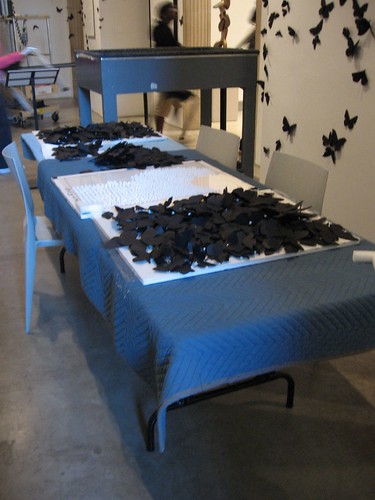
A preparators’ work table, with a few of the moths for Carlos Amorales’ installation, Black Cloud. The white dots are the tack for attaching each moth to the wall.
Four museum preparators were working assembly-line style, putting together the moths already swarming all over the walls near the video room when I arrived yesterday, the day before the opening, at the Carlos Amorales exhibit at the Philadelphia Museum of Art, Four Animations, Five Drawings, and a Plague. Amorales’ assistant Eduardo was up on a lift, attaching more of the moths to the walls.
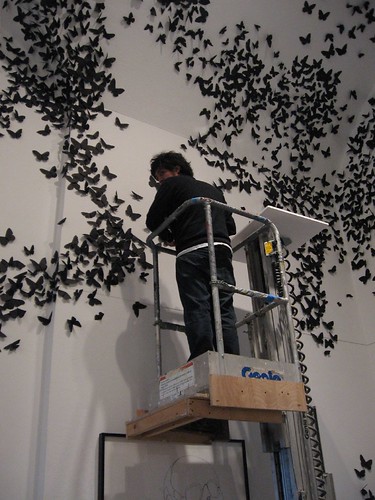
Amorales’ assistant, Eduardo, installing moths
I had just come from an ant invasion in my kitchen, three somewhat wearing days of beating back the beasts, so the swarms seemed incredibly important to me–important about the way we share the world with all kinds of things that are all at once wonderful and interesting and loathesome and fear-inducing.
Morales’ is the latest installment of the PMA’s Live Cinema series. He is exhibiting four videos in the museum’s video gallery (which has a swank new curtain–a screen-like weave–that no longer feels like the entry to a peep show).
At 6 p.m. today, you can attend a conversation between Amorales and exhibit curator Adelina Vlas, Seminar Room, ground floor, free after Museum admission.
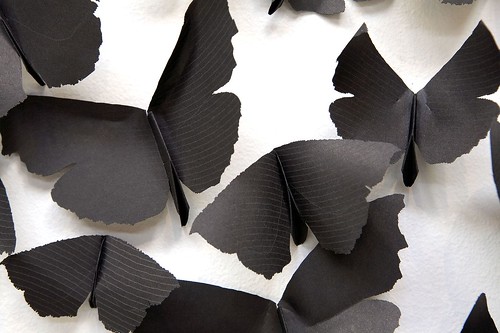
Black Cloud, 2007. Black paper moths.
© Carlos Amorales. Collection of Diane and Bruce Halle. Courtesy of the artist and Yvon Lambert New York, Paris. (the moths at the PMA are completely black)
Live Cinema is a series of film and video programs exploring single-channel video and film by local, national and international artists. The series has been pretty off-beat and unexpected, and thought-provoking. This exhibit is my fave, so far–accessible, juicy and just a little uncomfortable and ambiguous.
Amorales, an appealing fellow of 47, was there and cheerfully answered my questions, until I finally got to sit down with him and watch his videos (more on them later) and talk about the computer drawings, which he is showing for the first time.
Since the moths installation, Black Cloud, reminded me of Hitchcock’s The Birds, I immediately wanted to know if he was a movie fan.
He said he watched a lot of cinema, including Hitchcock.
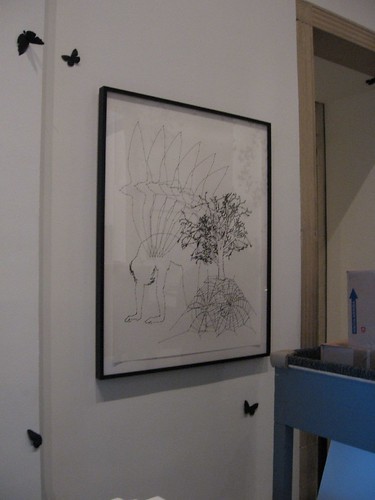
Carlos Amorales, Selected Ghosts, computer vector line drawings created collaboratively, based on Amorales’ “Liquid Archive” of imagery that he uses in his art.
He cited art influences Francis Picabia, with his use of layers and line as an influence for the vector line drawings, Selected Ghosts, also on exhibit. And he also mentioned an interest in the etchings of Mexican artist Jose Posada. “The graphic arts history of Mexico, I feel a connection,” he said. He later mentioned the personal side Goya, even when depicting the Battle of Waterloo, for example, and Edgar Allen Poe, too, for his ability to communicate a personal world view.
Amorales, lives and works in Mexico City. The first installation of the moths was in his studio there. His assistant did research about moth behavior to help them understand how the swarm should look, and it took them eight months until they got it right–right enough to unsettle Amorales’ neighbors and the water delivery man. “It was in a space for living, and it made it more like a plague,” he said.
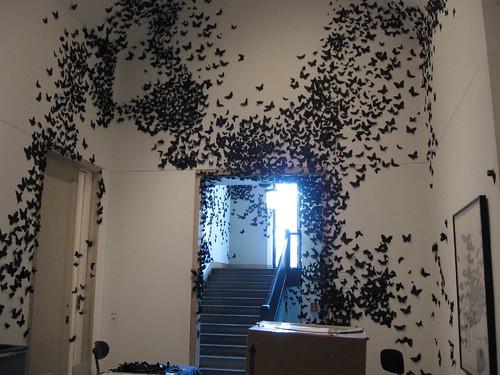
Carlos Amorales, Black Cloud, during installation at the Philadelphia Museum of Art
In the Art Museum’s high, groined ceilings, the moths look great. “Architecture gives the shape,” Amorales said. In the New York installation, he said, it looked more pictorial (in New York, at his gallery Yvon Lambert). He pushed the moths inside where people work. “The boundaries [of natural phenomena] are not rational.
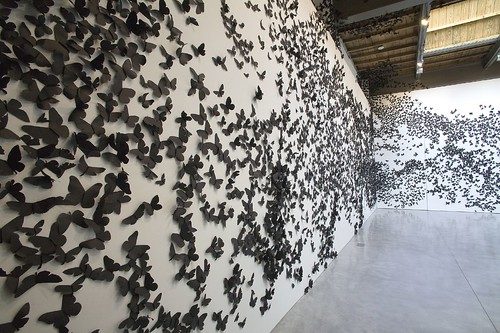
“I am interested in how the moths occupy a place, about the formal quality of things. They could become political or social events. I try not to illustrate issues in my work. That’s what happened with the Mexican muralists. Their work became like comics and illustrations.
“We live in a different period. It’s much more ambiguous. Ideology can be positive or negative. It’s hard to take a position anymore. During the Cold War, things were clearly divided–the Communists, the West. After that, it’s hard philosophically to make a distinction.”
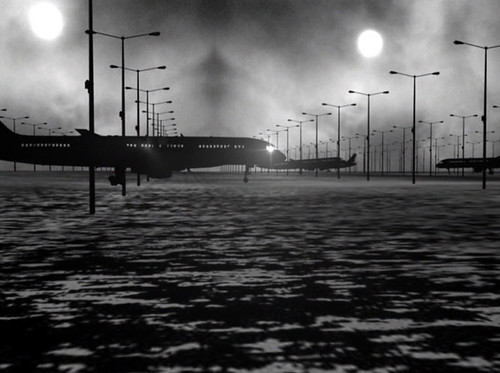
Manimal, 2005. Digital animation, 5’ 30”.
Direction by Carlos Amorales. Animation by Ivan Martinez Lopez. Music by Julian Lede. © Carlos Amorales. Courtesy of the artist and Yvon Lambert New York, Paris.
I asked about Amorales vocabulary of images–like silhouettes of figures, animals, trees, buildings, etc.– that he uses in different ways over and over. He said they are stored on the computer, and when he needs a real-world version, he has a laser cutter do the job (so no, he didn’t cut out all those moths by hand, one by one).
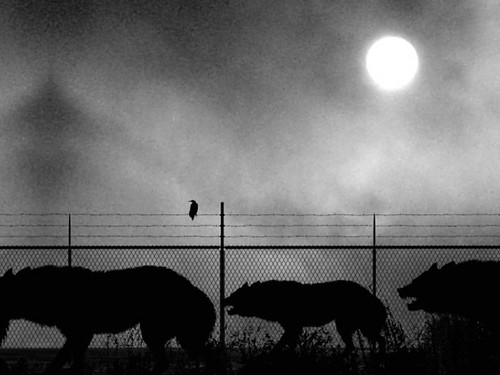
Manimal, 2005. Digital animation, 5’ 30”.
Direction by Carlos Amorales. Animation by Ivan Martinez Lopez. Music by Julian Lede. © Carlos Amorales. Courtesy of the artist and Yvon Lambert New York, Paris.
“The way I compose is through chance. The choice of options is rational. But then the choices get made by intuition.”
Sometimes Amorales collaborates with others to create his work. In his movies he has had friends contribute music. In his vector drawings, he works with a graphic artist.
“Someone else, the way they compose is different from me. It opens things up and I have to compromise.”
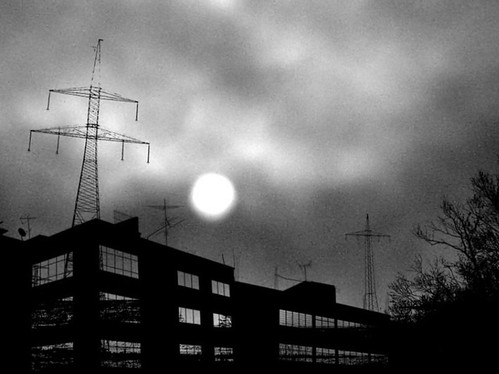
Manimal, 2005. Digital animation, 5’ 30”.
Direction by Carlos Amorales. Animation by Ivan Martinez Lopez. Music by Julian Lede. © Carlos Amorales. Courtesy of the artist and Yvon Lambert New York, Paris.
He went on to talk about how that process allows him to get out of his own mindset and see how the audience would react to what he is doing.
“There’s not art without artist. But there’s also no art without the audience. You have to communicate. If I paint for myself only, I’m not making art. I’m making creativity, maybe.”
His collaborations include the music for his videos and working with a computer graphics designer. Amorales and his best friend have a record label that includes work by Mexican bands, European bands and bands from Latin America. Amorales is not a musician. “My ideas are about how to present them, make a context for them.”
My hands down favorite of the four videos on view, Manimal (2005), is a black-and-white animation that combines flat silhouetted images with a weird, computer-y exploration of 3-D space. People become animals, birds become planes and a sense of foreboding dominates in post-apocalyptic scenes that include a lifeless forest and an urban industrial zone. I am reminded of some of Josh Mosley‘s videos.
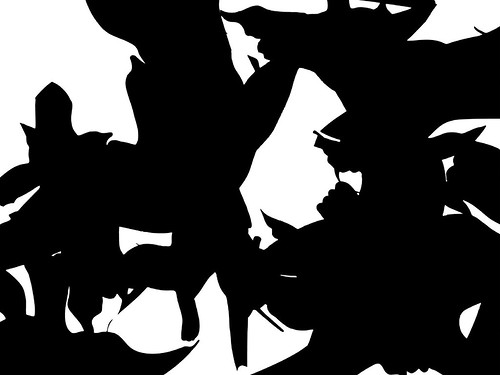
Faces, 2007. Digital animation after paper cut out plates, 23’10”. Direction by Carlos Amorales.
Animation by Ivan Martinez Lopez. Music concept by Julian Lede. © Carlos Amorales. Courtesy of the artist and Yvon Lambert New York, Paris.
The other videos, like Manimal all black and white short-short animations, include Forest, Rorschach Test Animation, and Faces (the most abstract, with the A and B sides of an old Argentine record of 20th century classical music played simultaneously).








